 Facebook
Facebook
 X
X
 Instagram
Instagram
 TikTok
TikTok
 Youtube
Youtube
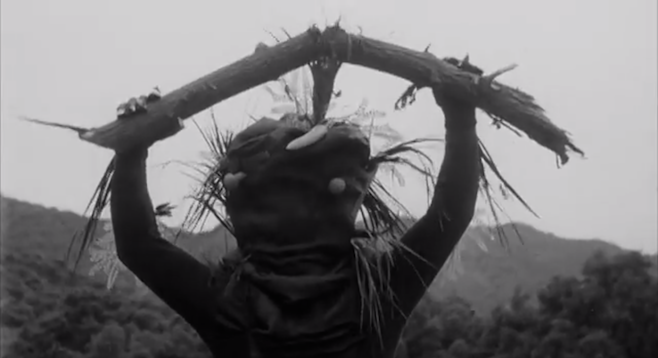
[Annotations appear in brackets.]
Some nights, quality just won’t do, and last night was one of them.
There are a couple of file boxes buried in my closet — bursting with DVD titles unfit to shelve in the company of quality — for just such an occasion. It was there, lounging among copies of Hot Potato, Cannonball Run 2, The Babe Ruth Story, Men of Boy’s Town, and Judgment at Nuremberg, that I found my evening’s entertainment. [Astonishingly, Marks makes no mention here of his most deeply buried closet treasure: his homemade Criterion Collection: The Complete Works of Stephen Spielberg box set. Normally, he can’t resist an opportunity to trot out his hand-drawn Saul Bass homage cover art for E.T. Someday, Scott — someday.]
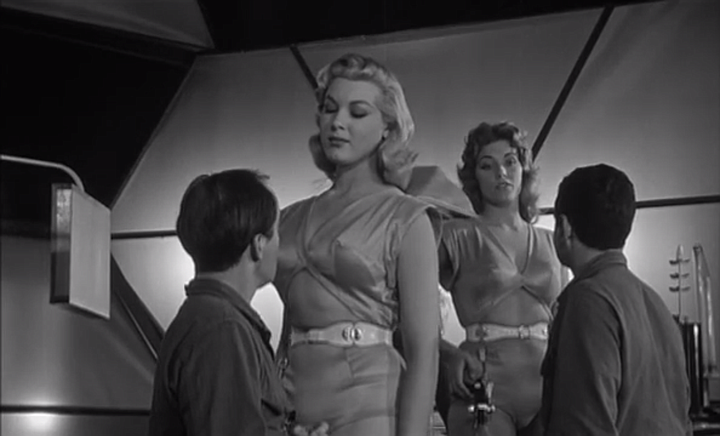
The hilarious trailer for this amateurish blend of low-brow humor and lower-budgeted sci-fi became a cornerstone of my VHS library on the evening USA Network’s Night Flight first aired it back in the early ’80s. A Leo Gorcey wannabe (Frankie Ray) puts the moves on a busty “galaxy gal” as our pantingly over-modulating ’60s trailer voice states the obvious: “Look at these great big beautiful babes.” The astro-Amazon towers over our 5-foot, 3½-inch hero keeping his eyes breast-level at all times. All this and a hand-painted long shot of Cape Canaveral! [VHS stands for Video Home System — basically, they were oversized cassette tapes with movies on them. Night Flight was a showcase for cult films like Eraserhead, camp films like Daughters of Darkness, uncensored(!) music videos, and Church of the SubGenius recruitment tapes. The ’80s were weirder than you may know. Leo Gorcey was an iconic diminutive street tough; between 1937 and 1956, he starred in nearly 70 Dead End Kids, East Side Kids, and Bowery Boys films.]
After 90 seconds I was sold and had to track down a copy. Rule of order — whenever a preview narrator feels the need to tell us that “the laughs come fast and free,” bet the opposite. [Which, paradoxically, means that Marks thought it was hilarious.]
The script was written by Roger Corman regular Jonathan Haze. Its original title, Monsters from Nicholson Mesa, was aimed at poking fun of American International Pictures’ honcho James H. Nicholson. Haze, best remembered as Seymour Krelboyne in Little Shop of Horrors, intended the script as a showcase for himself and fellow Corman stalwart Dick Miller. Instead, we get two comics that make Tenacious D look like Keaton and Arbuckle. [Roger Corman is the astonishingly prolific B-movie mogul who helped launch the careers of Francis Coppola (Dementia 13), Jack Nicholson (The Cry-Baby Killer), and Martin Scorsese (Boxcar Bertha). “Keaton and Arbuckle” refers to two famous silent-film stars, Joseph Frank “Buster” Keaton and Roscoe Conkling “Fatty” Arbuckle, who starred together in 1917’s The Butcher Boy.]
Pvt. Penn (Ray) is all eyebrows, macho Brooklynese, and hobbling one-liners. No one tacks an extra syllable on the word “bay-be-ee” quite the way he does. His partner and constant study in contrasts, Philbrick (Robert Ball), is a nasal wussy. Get the potential for comedic contrast? Director Bruno VeSota (The Brain Eaters) sure didn’t. [Fun fact: Leonard “Spock” Nimoy appeared in The Brain Eaters.]
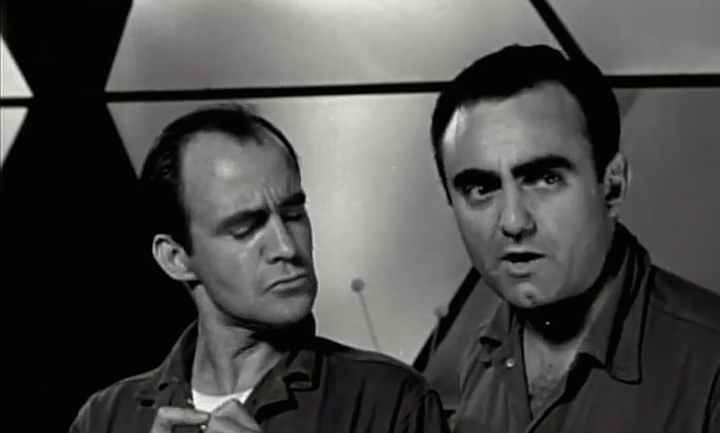
Stock footage and the same lech who narrated the trailer set the scene at Fort Nicholson, the world’s center for atomic research. Military scientists discover a mysterious crater in an atomic detonation area and dispatch a platoon of idiots to investigate. We hear talk of the “world’s greatest scientists working together” and “our first line of defense” only to cute-cut to a couple of “hand-picked” expert yardbirds who can’t even handle a garden hose. If you didn’t already take a hint from the (Wow!) placed next to two bimbos’ names in the credits, this is the level of humor you can anticipate over the next hour. [“Yardbird” here means “basic military trainee.” In other contexts, it can mean “prisoner” or “chicken.”]
Audrey Hepburn and Shirley MacLaine demanded similar billing in The Children’s Hour but the studio stood firm. [The Children’s Hour was a heavyweight drama about two women who suffer tremendously after a spiteful girl accuses them of being lesbians.]
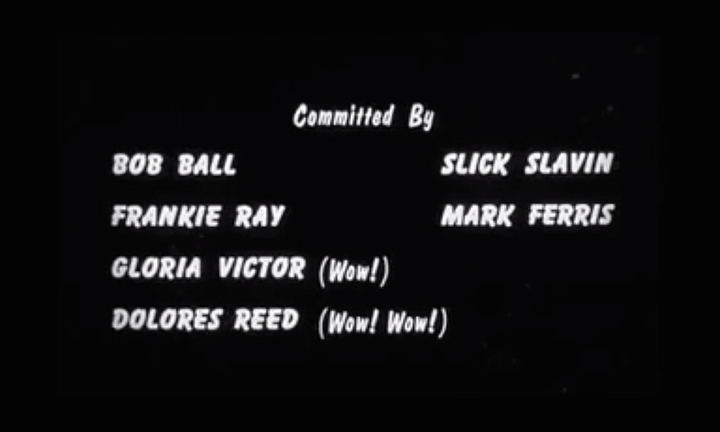
The staging is mortifying. Stop the camera, move it 45 degrees to the right, and restart the actors from where they left off. You want laughs? Stick one jamoke in a garbage can, have the other light up a cigar (make sure a “No Smoking” sign blinds the audience), and toss it lightly on top. A pacifist soldier weeps over killing a rattlesnake. Stupefying impressions of Warner Bros.’ gangsters are ours for the asking. Toy ray-guns with hardware-store funnels jammed in the barrels pass for futuristic weaponry. Not one original joke or concept, and still the filmmakers can’t find an acceptable way to present them! [Marks’s outrage here is entirely feigned. He is delighted by the incompetence on display. “Jamoke” is Chicago-based slang for someone dumber than a cup of coffee; the word is a mashup of “java” and “mocha.”]
While the duo goldbricks, their platoon explores a cave containing a race of extraterrestrial tree people — stiff, burlap-clad, button-eyed extras waving their branches and acting scary. The limber lumbermen direct the boys to a spaceship commanded by two Amazon playmates, Prof. Tanga (Gloria Victor, Wow!) and her assistant Dr. Puna (Dolores Reed, Wow! Wow!), bent on world domination through vegetables. [“Goldbricking” here means “slacking off.” It originally referred to swindling. The idea was that a goldbricker would do anything — including commit a crime — in order to avoid honest hard work.]
They hail from the nonexistent but real-sounding planet Chalar in the Belfar star system. For ten years the galaxy gals have been on Earth, perfecting a race of Vegemen that grow in soil brought from their planet. The boys treat their own abduction as if it were a first date. The Naugahyde-bikini cuties are out of this world! The looming Dr. Puna begs to be taught the language of love, Philbrick-style. (Instead of re- recording Cyrano Penn’s romantic play-by-play, you can hear him echoing the lines just off-camera.) [“Cyrano” here refers to the large-nosed Frenchman Cyrano de Bergerac. In a play based on his life, he is forced by his (self-perceived) ugliness to woo his beloved vicariously through a more conventionally handsome man.]
We’ll pause a moment for those who just got the “Puna-Tanga” reference.
His kiss Wows! the Wow!Wow! and, using a cigarette lighter as a compass (don’t ask), they make their escape. Borrowing from a Republic oater, the duo start a papier-mâché boulder avalanche that fails to stop the oncoming “Spacetro Nuts.” The “broads” call them off, and Capt. Awol, a character I had hoped we were done with, is brought back into play. The filmmakers deemed this the right time to experiment with genre expectations as a group of Indians unexpectedly arrive on horseback. This allows room for plenty of “kemosabe” and “peace pipe” jokes to pad the scant running time. [“Oater” refers to a Western movie, due to the use of oats as horse fodder.]
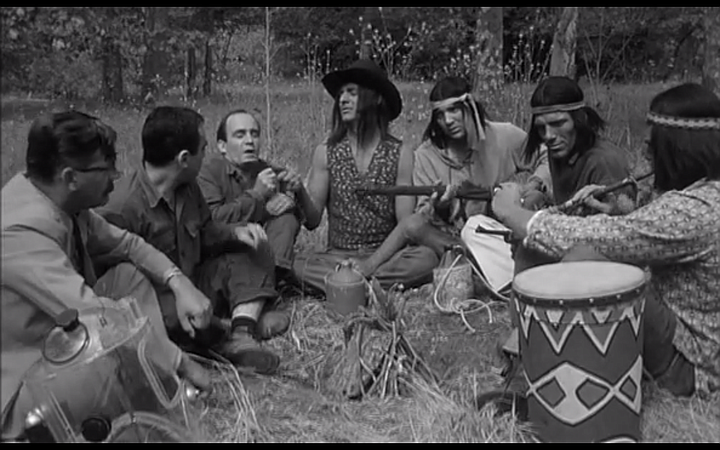
After catching a buzz, the boys return to their home base where Philbrick saves the world by accidentally launching the spaceship. Puna’s hots for the Earthman convinces Tanga to, “in the interest of science,” kiss Penn. “Stand by for a charge, Bay-bee-ee!” Equating love with slavery, the dames return to Earth, become domestic robots, and wave at stock footage while their beaus are being honored.
The film debuted in the summer of 1962 on the bottom-half of a double-bill with the far-more cerebral The Brain That Wouldn't Die. Robert Ball went on to appear in Easy Rider. Kudos to Dennis Hopper for casting him as a mime. Frankie Ray immediately followed his role as Pvt. Penn with another tour of duty in the TV series Combat and has been missing in action ever since. [Double-bill: During the Great Depression, theaters began offering two movies for the price of one. This was actually cheaper than the customary practice of featuring a live act, a cartoon, a comedy short, a novelty short, a newsreel, and a feature presentation.]


[Annotations appear in brackets.]
Some nights, quality just won’t do, and last night was one of them.
There are a couple of file boxes buried in my closet — bursting with DVD titles unfit to shelve in the company of quality — for just such an occasion. It was there, lounging among copies of Hot Potato, Cannonball Run 2, The Babe Ruth Story, Men of Boy’s Town, and Judgment at Nuremberg, that I found my evening’s entertainment. [Astonishingly, Marks makes no mention here of his most deeply buried closet treasure: his homemade Criterion Collection: The Complete Works of Stephen Spielberg box set. Normally, he can’t resist an opportunity to trot out his hand-drawn Saul Bass homage cover art for E.T. Someday, Scott — someday.]

The hilarious trailer for this amateurish blend of low-brow humor and lower-budgeted sci-fi became a cornerstone of my VHS library on the evening USA Network’s Night Flight first aired it back in the early ’80s. A Leo Gorcey wannabe (Frankie Ray) puts the moves on a busty “galaxy gal” as our pantingly over-modulating ’60s trailer voice states the obvious: “Look at these great big beautiful babes.” The astro-Amazon towers over our 5-foot, 3½-inch hero keeping his eyes breast-level at all times. All this and a hand-painted long shot of Cape Canaveral! [VHS stands for Video Home System — basically, they were oversized cassette tapes with movies on them. Night Flight was a showcase for cult films like Eraserhead, camp films like Daughters of Darkness, uncensored(!) music videos, and Church of the SubGenius recruitment tapes. The ’80s were weirder than you may know. Leo Gorcey was an iconic diminutive street tough; between 1937 and 1956, he starred in nearly 70 Dead End Kids, East Side Kids, and Bowery Boys films.]
After 90 seconds I was sold and had to track down a copy. Rule of order — whenever a preview narrator feels the need to tell us that “the laughs come fast and free,” bet the opposite. [Which, paradoxically, means that Marks thought it was hilarious.]
The script was written by Roger Corman regular Jonathan Haze. Its original title, Monsters from Nicholson Mesa, was aimed at poking fun of American International Pictures’ honcho James H. Nicholson. Haze, best remembered as Seymour Krelboyne in Little Shop of Horrors, intended the script as a showcase for himself and fellow Corman stalwart Dick Miller. Instead, we get two comics that make Tenacious D look like Keaton and Arbuckle. [Roger Corman is the astonishingly prolific B-movie mogul who helped launch the careers of Francis Coppola (Dementia 13), Jack Nicholson (The Cry-Baby Killer), and Martin Scorsese (Boxcar Bertha). “Keaton and Arbuckle” refers to two famous silent-film stars, Joseph Frank “Buster” Keaton and Roscoe Conkling “Fatty” Arbuckle, who starred together in 1917’s The Butcher Boy.]
Pvt. Penn (Ray) is all eyebrows, macho Brooklynese, and hobbling one-liners. No one tacks an extra syllable on the word “bay-be-ee” quite the way he does. His partner and constant study in contrasts, Philbrick (Robert Ball), is a nasal wussy. Get the potential for comedic contrast? Director Bruno VeSota (The Brain Eaters) sure didn’t. [Fun fact: Leonard “Spock” Nimoy appeared in The Brain Eaters.]

Stock footage and the same lech who narrated the trailer set the scene at Fort Nicholson, the world’s center for atomic research. Military scientists discover a mysterious crater in an atomic detonation area and dispatch a platoon of idiots to investigate. We hear talk of the “world’s greatest scientists working together” and “our first line of defense” only to cute-cut to a couple of “hand-picked” expert yardbirds who can’t even handle a garden hose. If you didn’t already take a hint from the (Wow!) placed next to two bimbos’ names in the credits, this is the level of humor you can anticipate over the next hour. [“Yardbird” here means “basic military trainee.” In other contexts, it can mean “prisoner” or “chicken.”]
Audrey Hepburn and Shirley MacLaine demanded similar billing in The Children’s Hour but the studio stood firm. [The Children’s Hour was a heavyweight drama about two women who suffer tremendously after a spiteful girl accuses them of being lesbians.]

The staging is mortifying. Stop the camera, move it 45 degrees to the right, and restart the actors from where they left off. You want laughs? Stick one jamoke in a garbage can, have the other light up a cigar (make sure a “No Smoking” sign blinds the audience), and toss it lightly on top. A pacifist soldier weeps over killing a rattlesnake. Stupefying impressions of Warner Bros.’ gangsters are ours for the asking. Toy ray-guns with hardware-store funnels jammed in the barrels pass for futuristic weaponry. Not one original joke or concept, and still the filmmakers can’t find an acceptable way to present them! [Marks’s outrage here is entirely feigned. He is delighted by the incompetence on display. “Jamoke” is Chicago-based slang for someone dumber than a cup of coffee; the word is a mashup of “java” and “mocha.”]
While the duo goldbricks, their platoon explores a cave containing a race of extraterrestrial tree people — stiff, burlap-clad, button-eyed extras waving their branches and acting scary. The limber lumbermen direct the boys to a spaceship commanded by two Amazon playmates, Prof. Tanga (Gloria Victor, Wow!) and her assistant Dr. Puna (Dolores Reed, Wow! Wow!), bent on world domination through vegetables. [“Goldbricking” here means “slacking off.” It originally referred to swindling. The idea was that a goldbricker would do anything — including commit a crime — in order to avoid honest hard work.]
They hail from the nonexistent but real-sounding planet Chalar in the Belfar star system. For ten years the galaxy gals have been on Earth, perfecting a race of Vegemen that grow in soil brought from their planet. The boys treat their own abduction as if it were a first date. The Naugahyde-bikini cuties are out of this world! The looming Dr. Puna begs to be taught the language of love, Philbrick-style. (Instead of re- recording Cyrano Penn’s romantic play-by-play, you can hear him echoing the lines just off-camera.) [“Cyrano” here refers to the large-nosed Frenchman Cyrano de Bergerac. In a play based on his life, he is forced by his (self-perceived) ugliness to woo his beloved vicariously through a more conventionally handsome man.]
We’ll pause a moment for those who just got the “Puna-Tanga” reference.
His kiss Wows! the Wow!Wow! and, using a cigarette lighter as a compass (don’t ask), they make their escape. Borrowing from a Republic oater, the duo start a papier-mâché boulder avalanche that fails to stop the oncoming “Spacetro Nuts.” The “broads” call them off, and Capt. Awol, a character I had hoped we were done with, is brought back into play. The filmmakers deemed this the right time to experiment with genre expectations as a group of Indians unexpectedly arrive on horseback. This allows room for plenty of “kemosabe” and “peace pipe” jokes to pad the scant running time. [“Oater” refers to a Western movie, due to the use of oats as horse fodder.]

After catching a buzz, the boys return to their home base where Philbrick saves the world by accidentally launching the spaceship. Puna’s hots for the Earthman convinces Tanga to, “in the interest of science,” kiss Penn. “Stand by for a charge, Bay-bee-ee!” Equating love with slavery, the dames return to Earth, become domestic robots, and wave at stock footage while their beaus are being honored.
The film debuted in the summer of 1962 on the bottom-half of a double-bill with the far-more cerebral The Brain That Wouldn't Die. Robert Ball went on to appear in Easy Rider. Kudos to Dennis Hopper for casting him as a mime. Frankie Ray immediately followed his role as Pvt. Penn with another tour of duty in the TV series Combat and has been missing in action ever since. [Double-bill: During the Great Depression, theaters began offering two movies for the price of one. This was actually cheaper than the customary practice of featuring a live act, a cartoon, a comedy short, a novelty short, a newsreel, and a feature presentation.]
Comments